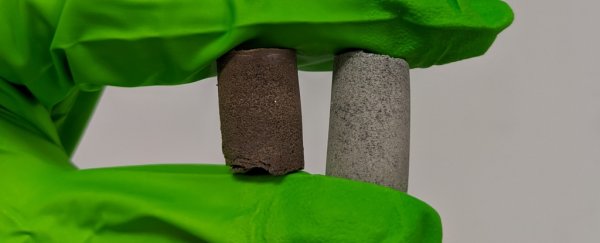The homes we create on Mars and the Moon may end up being just a tad less hygienic than the structures we live in here on Earth.
A new series of experiments has resulted in the successful fabrication of concrete that could one day be used in off-world colonies, using a combination of simulated regolith from Mars or the Moon, a protein found in human blood, and a compound found in human urine, sweat, and tears.
These biocomposite materials are even stronger than regular concrete, and would be suitable for making buildings on other worlds – if you could get astronauts to volunteer to be blood bags, that is.
Nevertheless, it demonstrates that building materials can be found in the last places you might think to look, if you can think creatively.
It's not a new idea – animal blood was used to bind mortar in the Middle Ages – but it's not a solution one might expect to find in the Space Age. New or not, it could help solve a huge problem with establishing off-world colonies – the huge cost.
"Scientists have been trying to develop viable technologies to produce concrete-like materials on the surface of Mars, but we never stopped to think that the answer might be inside us all along," said materials engineer Aled Roberts of the University of Manchester in the UK.
 Mars and Moon biocomposites. (University of Manchester)
Mars and Moon biocomposites. (University of Manchester)
When we do finally establish human settlements off-Earth, we're going to have to be a bit creative. Every ounce on a rocket payload counts.
According to the latest data, it costs at least US$1,500 for each kilogram included in a rocket launch, never mind actually getting it there. A 2017 report found that it could cost as much as US$2 million to ship a single brick to Mars.
So if we can construct buildings out of materials that are already to hand, that will be a huge load off – quite literally.
Experiments have been conducted using regolith simulants for the Moon and Mars (that's the top layer of dirt and rubble on the surface of these worlds), showing that these regoliths can be viable building materials. But you still need to glue them together, and that's where the human body could come in.
Last year, an international team of scientists found that a compound in human urine called urea helps plasticize concrete, making it less brittle and more flexible, which ultimately results in a hardier material that can better withstand mechanical stresses. Roberts and his team have taken it a step further.
Their material, called AstroCrete, uses a protein called albumin, found in human blood plasma, to bind the concrete together. Using a simple fabrication technique, the team used human serum albumin to produce extraterrestrial regolith biocomposites.
These materials had compressive strengths as high as 25 megapascals, comparable to the strengths between 20 and 32 megapascals found in ordinary concrete here on Earth. Adding urea made the material even more impressive, increasing the compressive strength of AstroCrete to up to 39.7 megapascals.
 3D-printed Mars AstroCrete. (University of Manchester)
3D-printed Mars AstroCrete. (University of Manchester)
Synthetic spider silk and bovine serum albumin, which both might be available on Mars at some point, were also tested, and could also work. But the initial supply of blood protein would be harvested from astronauts, according to the team's paper.
"In essence, human serum albumin produced by astronauts in vivo could be extracted on a semi-continuous basis and combined with Lunar or Martian regolith to 'get stone from blood', to rephrase the proverb," the researchers wrote.
Over a two-year span, six humans could donate enough albumin to build 500 kilograms of AstroCrete. The contribution of each crew member would provide enough building material to expand the habitat to accommodate that person, the researchers' calculations found.
But a great deal of further research is required. We don't know the long-term health effects of continuous plasma donation in a low-gravity, high-radiation environment. We also don't know how much plasma can be taken from a single person sustainably, and how that might affect fatigue levels.
However, it might only be a short-term solution. Once the base is established, there may be no more need for donations.
"We believe that human serum albumin extraterrestrial regolith biocomposites could potentially have a significant role in a nascent Martian colony," the researchers wrote, "but will eventually be superseded by versatile bioreactors or other technologies as they mature."
Phew.
The research has been published in Materials Today Bio.
